SUBURBIA
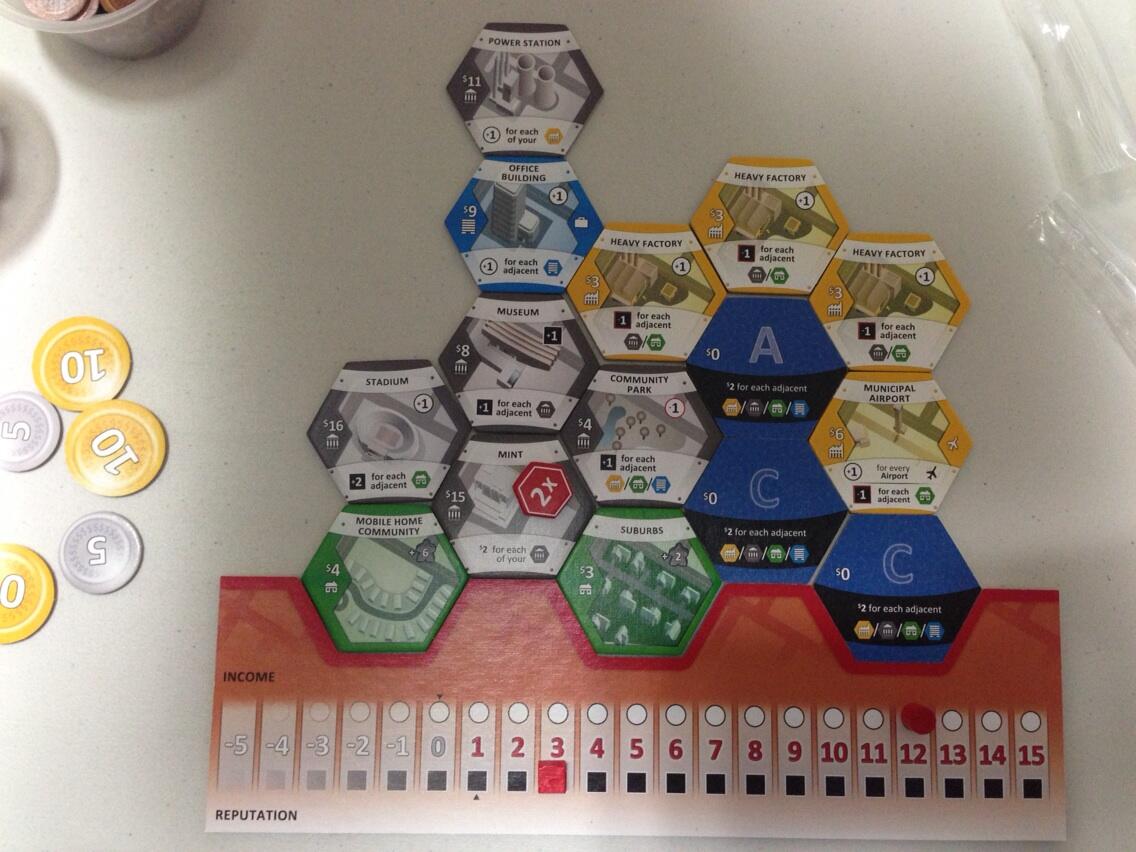 |
| Mint did not save me :( |
Game Session and Thoughts:
Lost quite horribly and to 2 newbies (who have never played this game before) to rub it in! I think the main problem was that I changed my engine to a reputation scoring one too late into the game. I should have started to grab reputation instead of income when the B tiles starting showing up in the game. This game requires good planning and knowing when to change from a money generating engine to a reputation generating one. Timing is also quite important but some part is based on luck, referring to the tiles that are drawn. Sometimes the tile that you want will not be affordable to you but will be for someone else down the row. Furthermore, if the player before you is pretty much going on the same track then it will be quite difficult for you.
Conclusion:
I have ordered my promo from the BGG store and while I know it doesn't add a lot to the game I will welcome the variety. I twittered about this and Bezier Games replied that there will be an expansion for Suburbia and its already in the late stages of development! That I feel is what the game needs. Similar to Agricola and Le Havre 2 players, With a wider variety of buildings or perhaps even more features, it will increase the interaction amongst players as well as the replayability of the game. This is still recommended from me and I cannot wait to try a few more solos to hone my skills! :D
CO2
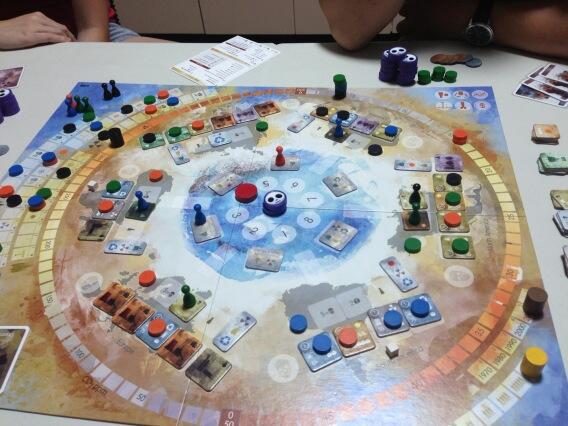 |
| I am the Black player btw... |
Game Session and Thoughts:
Ah finally I get to bring this monster out again to play it PROPERLY this time. Another friend was there and she was also hoping to finally play it properly after a mistake-filled first game for her. We were also using this to see if her sister was up to taking on heavier games. Short answer first, she is and she was scoring pretty well (our final tallies were in the 100+ which is surprising to me as well). Quite early on I ran into the issue which Jon previously talked about and which is a pet peeve for others and that is what is the point of me installing a project when it will just be stolen by another player? I had a small discussion with another player in my latest game about this and he mentioned that it is more beneficial to propose and install projects versus actually building them. Now I have not deeply analysed this to see if its true but if it is, then it certainly makes sense in a game that has quite a few rules already going against the norm (i.e. buying a CEP doesn't increase the market price). Now don't be mistaken that you can ignore constructing power plants entirely, you need to have a few for those quick scoring points and possible ownership of a region and thus grabbing all its left over CEPs at the end of the game and of course, to score UN cards, but perhaps the focus shouldn't be on over constructing. Perhaps a better plan is to install appropriate projects so as to manipulate the others to use up their resources or build plants where it is not very beneficial to them.
Conclusion:
I will want to give this game a few more tries to see if I can break through the surface and finally appreciate this game for all its worth. Right now it feels as if I am just only scratching the surface with this rather multi-layer game. I want to say that this game is recommended but I know that it is not for everyone and given the complexity to teach, absorb and then being able to play this game well, I will have to say its a try before you buy. Oh and do see if you can print out some stickers to pimp out your CEPs, they look much nicer that way ;)
SATOR AREPO TENET OPERA ROTAS
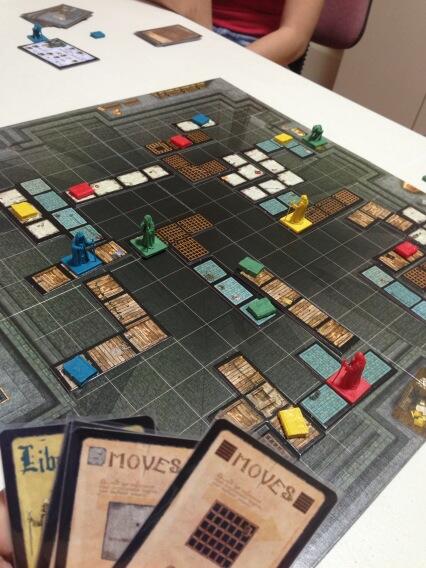 |
| Green player won. I was Yellow. |
Game Session and Thoughts:
I wanted to bring this out again to see if it will survive to have a place in my collection. Sadly though after this play I don't think I will keep the game. This time we played with the full complement of 4 players and while I started sabotaging early on, it seems that we did not do a good job guarding a player and by the 3rd round or so, he had managed to collect all this books and won the game. I had only collected 2 by then but I was nowhere near the 3rd or 4th book.
Pet Peeves:
This game requires a lot of spatial awareness and the 2 ladies that I was playing with were complaining about this point. We discussed a little as well about gender and spatial awareness and but I will not get into THAT discussion :P
Another pet peeve about the game is the luck of the draw. Sometimes you have cards in your hand that doesn't help you at all and instead of wasting a turn to draw new cards, you might as well play cards to try to prevent anyone else from grabbing their books. I suspect that if this was played properly (with everyone guarding each other), this could be a very frustrating game as there is no timer function that will end the game after a certain number of rounds.
Conclusion:
After playing with 4, I feel that perhaps this game is best played with 2 such that you are aware of what each other is doing and you will be constantly either helping yourself or screwing your single opponent. We haven't really explored using the Gargoyle yet but it can be easily dismissed by opponents by them discarding 3 cards. Unfortunately, this game is not for me and I won't be keeping it.
IL VECCHIO
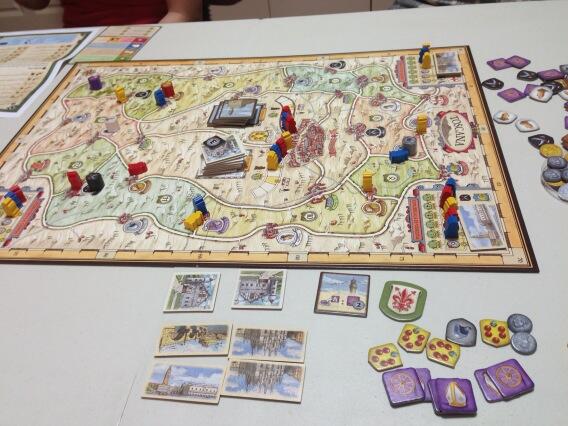 |
| I won! Using the use Priest and get Wheel + $2 as well power |
I managed to get the initial tile which gave me the bonus that when I took 2 Priests, I will get 1 Wheel + $2 as a bonus. My plan was to use that to my advantage to and then travel around for free. I also decided to go grab an end game tile early so I know what I was aiming for. Those really helped a lot as my end game objective was to grab the Medici crests and I was scrambling to place my worker on the rows to grab the tile. It helped also that they gave me bonus 1 point each at the end of the game. The game is easy to teach and quite straight forward. Unfortunately there's not really a lot of theme to it so that may make grasping the concepts a little bit tougher for new players. Iconography is simple and easy to understand after a few rounds and the component quality is nice with good art. The only small gripe I have was the inclusion of 2 boards that are the same except for colors. I do wish they have provided a different board to add to the replayability.
Conclusion:
I won with about 54 points but given that the scoring track is up to almost a 100, I am wondering if anyone can achieve that at all. Right now there is still a high replayability factor because of the different start bonus tiles we can grab as well as the bonus and end game scoring tiles we may get during the game. However I forsee that with many more plays the game may wear out. I am also not sure if this bonus tile that I have gotten is imbalanced but lets see if I manage to get future plays in if I can test this theory. Try before you buy!
THE CAVE
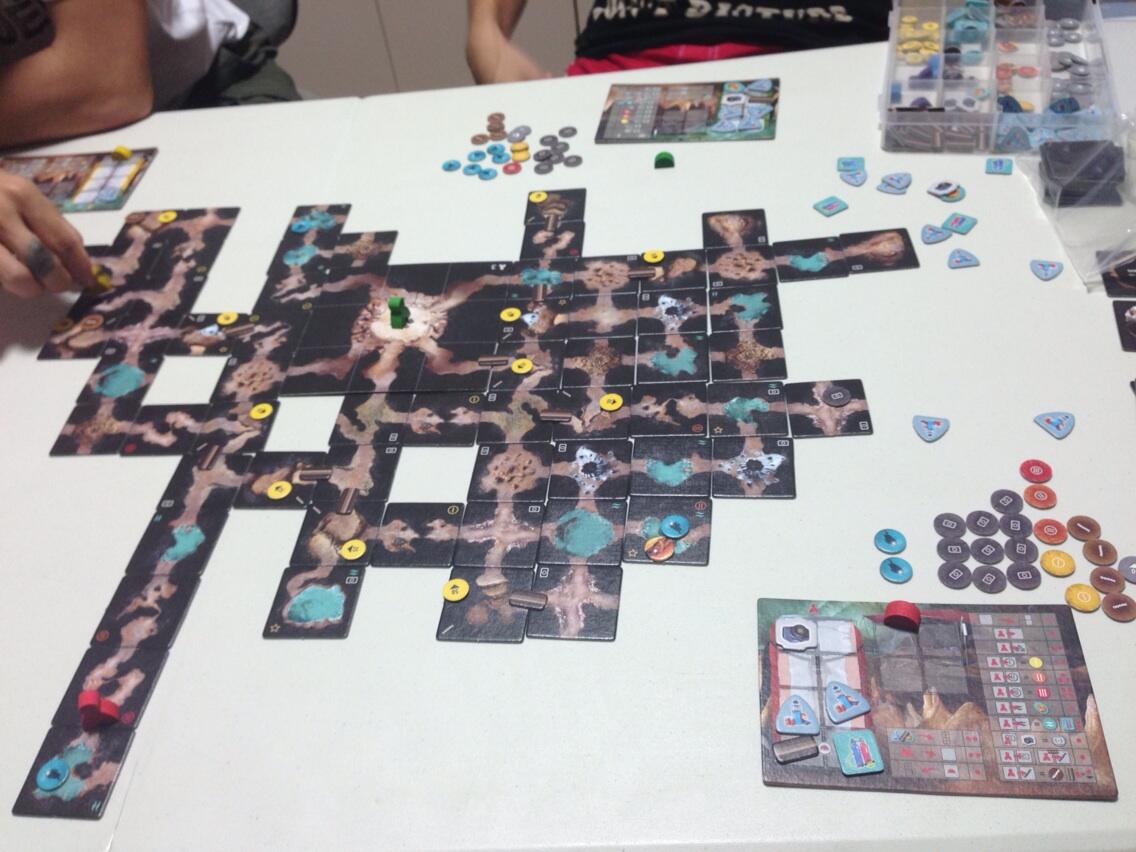 |
| Yawn... when is it ending ...? |
Game Session and Thoughts:
This is my first play of the game. I have played K2 previously and that brought me into the gaming group (Cult Of The New) that I am involved in right now. The Cave is from the same designers as K2 and while I was hoping to give this a go I have heard mixed reviews about this game.
Players are all explorers trying to navigate this cave system, by means of tile laying) and collecting tokens for actions done (i.e. taking picture, exploring lakes or navigating narrow passageways). Players need to carefully manage their resources as well and when the final cave tile is placed, have 2 turns to make it back to base camp or be disqualified. Players then count up their tokens and whoever has the most points will win the game.
Seems pretty straight forward game. We found ourselves moving around quite easily and then scampering back to base camp to replenish our supplies and then venturing out again. Repeat and Rinse until the last tile is revealed. I took a LOT of photographs and won by about 3 points. I did not do a lot of swimming in the lakes like my opponents but since most of the tiles I had revealed are photographs, I was lucky to win by that. That said, I don't have many good things to say about the game. What went wrong?
Pet Peeves:
For starters, I am not sure what the tent does. I mean it takes up 2 spaces in your backpack and you can spend 2 action points to set it up and gain access to the 4 spaces it provides. Ideally, it should allow you to extend your range so that you can explore further but the catch seems to be how are you going to get back to base camp then to replenish everything? If you can head back to your tent and replenish all the time, then that makes the tent much more valuable but for the entire game none of us were using the tents except when my friend tried to test the mechanism for this.
Supplies are a pain to manage. You are quite limited in terms of exploring tiles by how much supplies you are carrying before you have to high tail it back to base camp. If you run out of supplies, then you are spending your turn mostly moving 1 space. Its horrendously slow and painful if you do that as my friend discovered. As mentioned above, the tent doesn't seem to help much at all! Very odd.
The depth of the cave creates a very odd perception and some confusion with us. When you place a tile that has a rope icon, that means that this tile is deeper so you place a 25meters icon if this was the first you encountered. Now if you descend and encounter another similar tile, you place the 50meters icon and so on and so forth. However, there are cases where 2 separate tracks may be joined by placing a single cave tile and there in lies the problem of depth. If the 2 trails were of different depth to begin with, what happens when you join them together ? This depth concept may seem interesting and thematic, but game play wise can create confusion and I feel that it should be explained more clearly in the rules or with more examples.
Finally, the bits. There are a LOT Of chits for all different types of challenges faced as well as supplies, ropes etc etc. SO MANY MANY that you need a good plano box to ensure that everything is sort out nicely for easy setup and tear down.
Conclusion:
This game did not grab me like what K2 did. My friend commented that in K2 at least you can see clearly where you are heading and plan how to get there whereas The Cave is largely due to luck of your draw. You may end up getting screwed if you keep exploring lake tiles when you don't have a raft or oxygen tanks and have to head back to base camp just to reconfigure your inventory. Gameplay can get draggy as well due to the number of tiles you have to explore. Some players I guess can potentially drag the game on if they focused on clearing all the available spaces and not on exploring. This was a MEH for me and is not for me. Not recommended.
THE PALACES OF CARRARA
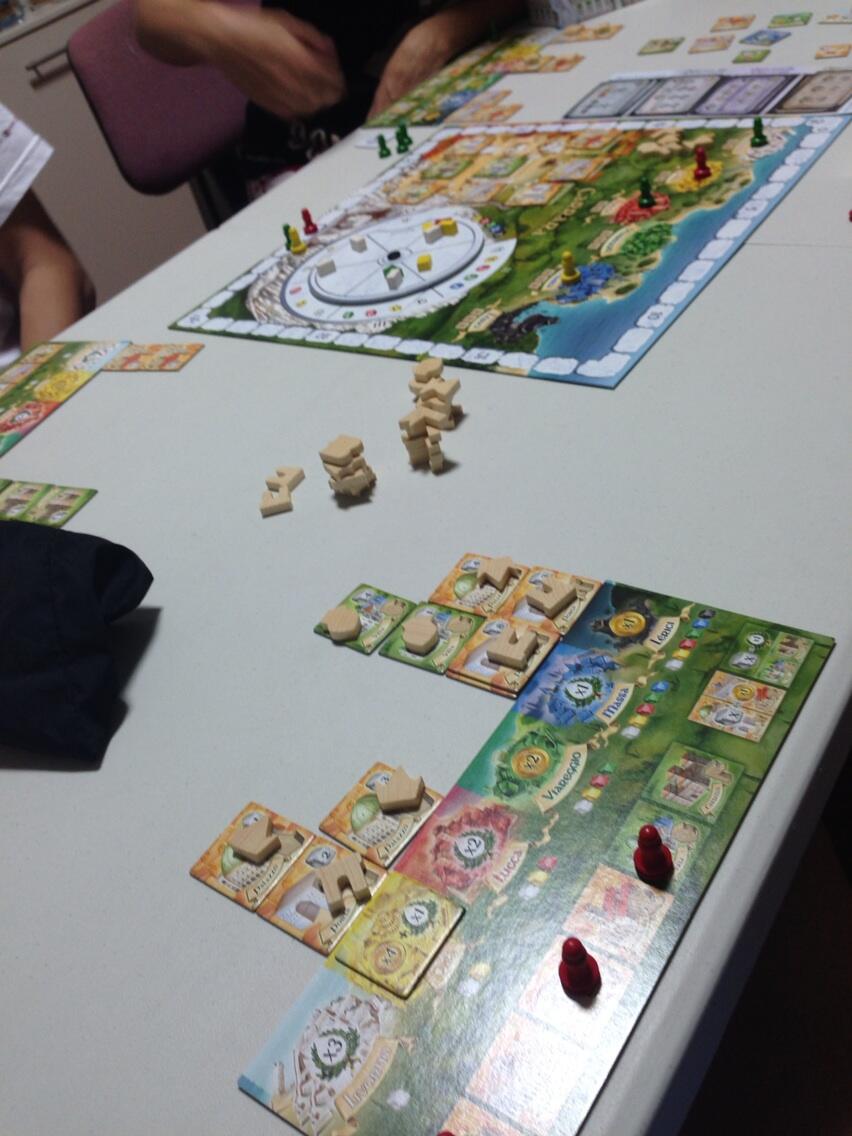 |
| Spin spin the wheel... |
Game Session and Thoughts:
This is my first play of the game. Ah another essen release which I have heard about and was interested to try but not interested enough to grab myself a copy. This is a game that includes a sealed envelope with instructions for an advanced game and advice that you play the basic game a few times before you embark on the advanced game. Being the seasoned gamers we are (*wink wink*) we decided to jump straight into the advanced. My opponents have played this once before but this is my first game. Explanation was simple enough and I could grasp the concepts easily. In the game, you are trying to manage your resources and determine when is the most opportune time for you to make use of your 6 scoring pawns (each can only be used once in the entire game). When some has met the end game conditions (3 cards determine the end game conditions), he/she can declare the game is over and score extra bonus points. Players then tally up all the points they have on the board and whoever has the most points is the winner.
There are quite a few interesting mechanism to the game. First is the resource wheel. At any 1 time, there should be at most 11 blocks in various colors (6 altogether I believe). The wheel is also divided into segments which shows prices of each color of block and are different from segment to segment. During your turn, if you decide to make a purchase from the wheel, you can either just select a segment and buy the blocks on it (any number) and pay the costs OR rotate the wheel once, populate the starting segment to top up total number of blocks to 11 and then make a purchase.
The blocks are used to buy building tiles which you can then place on different sections/cities on your board. The requirement to build the buildings is you must pay a number of blocks as denoted by the top right corner of the building tile and also depending on the section/city you wish to place. Leftmost city is WHITE and only allows building tiles which you have paid in WHITE blocks only. next city accepts buildings paid with YELLOW and/or WHITE blocks and the right most will accept buildings paid with ANY blocks.
The most important concept of the game are the scoring pawns. During your turn you can, instead of any of the other actions choose to score by placing a scoring pawn onto any of the scoring sections on your board or on the main board. On your board, you can for example, score all building tiles that have the same icon on it. Thus, depending on which city the building is in, you will score points/money or both. You will also collect that many icons as the number of buildings you have activated. The other type of scoring will be on the main board and only 1 scoring pawn can be allocated to each scoring space. These scoring spaces will score for all buildings in a particular city but only if you meet the requirements (i.e. for the Black city, you can only score if there are 3 buildings in that city). You will also get the tokens for those buildings you have not previously activated.
The final concept will be the objectives board which will show you 3 scoring objectives that also represent end game conditions as well as a bonus objective.
It is quite a fun game with good art, nice component pieces but not exactly dripping with theme. The scoring spaces make for a tense game as well because you need to monitor what your opponents are doing less they activate the scoring before you do.
Pet Peeves:
This is like a multi-player solitaire because the only interactions you will have will be the market where you can buy the stones and the limited scoring spots. But often I don't find myself being overly affected by these and was pretty much doing my own thing and playing my own game. Limited interaction.
There is also a runaway leader because it is often quite difficult to block someone from building in their city unless there is a cooperative effort to empty the market of that particular block. Our end game scoring were quite far apart with 2 of us almost getting looped by the leader.
Conclusion:
Its a light-medium weight Euro game that mixes a few interesting concepts together. Quite nicely executed and easy to learn and play. Not much interaction though. I will play it again but probably not like it enough to grab my own copy. A friend mentioned that this second time he played it did not seem as fun as the first. Oh I did not mention that timing is very important in the game because while you will often want to wait and store up resources before buying and scoring but if someone else grabs the spot before you, it may screw with your plans a bit. Try before you buy!
THE DOGE SHIP
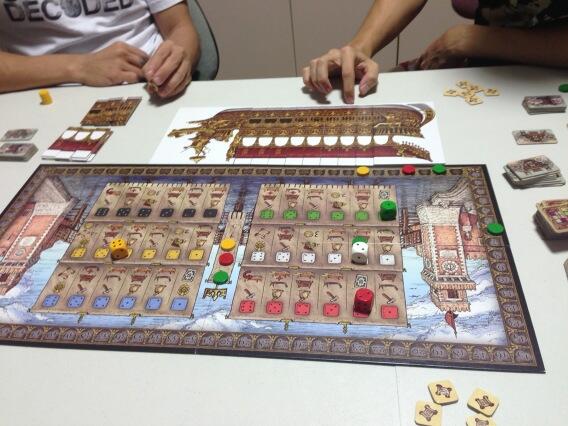 |
| Much screwage was committed... |
Game Session and Thoughts:
This is my first play of the game. I have heard of this game and seen the box and all but wasn't too interested in it. Still I was glad to have been able to give it a go when my friend bought it and brought it over.
The game is a light-medium weight euro where players are taking actions using action discs to build gondolas (for money and scrolls), barriers (for protection against high waters and special benefits when taking other actions), get money, purchase plans for gondolas and barriers and ships and ultimately, building the Doge ship which will also allow the game to end when the entire ship has been built.
At the start of a round, the start player will roll a number of dice (depending on the number of players) and place them in the corresponding track. All actions spaces up to where the die has been placed (i.e. if the red die is a 4, then action spaces to the left and up to the die can be activated) are free. Each spaces beyond that die will cost an additional $1 (i.e. if you want to activate Space 6 and the die is on 4, you will need to pay $2). Each player will have a number of action discs and taking turns, each player will place their action disc onto an action space and perform that activity. When all players have gone their turn, players will check the event card to see if it is High water or the Doge has arrived for an inspection.
For high water, players check the number of barriers they have against the number indicated on the event card. If they have less barriers, they will lose 2 action tokens for the next round. If they are equal, then they lose 1. Otherwise they are safe.
If its an inspection, players will now secretly bid a number of scrolls they have collected. The player with the most scrolls will score 6 points, the 2nd, 3 and so on.
The game will end only if the entire Doge ship has been completed and then players have a final inspection and whoever has the most points will win the game.
So you are trying to effectively chain your activities such that you can build 2 things with 1 action disc rather than taking 2 turns to build the things that you wanted. You are also trying to earn enough money to be able to buy a ship component and then build it later before your opponents do. There are 6 different sections to the ship requiring different number of ship components to complete the section however there is a space on the board which, when activated, allows you to replace another already built ship component. Art is quite straight forward and easy on the eyes. Components are nice cardboard quality chits. Interestingly, there is a money track instead of money chits to denote how much money you have.
Pet Peeves:
The main pet peeve will be the length of the game. We had quite a lot of fun building barriers and gondolas but not so the actual ship itself. If all players end up milling around and not building the ship, then the game could drag on and be lengthy. However, since building the ship will score you points, I don't think this will be a big issue.
Conclusion:
It is a nice game but doesn't bring much new things or concepts. Most of the mechanisms you will have probably played in other games already so nothing new there. I will play it again perhaps with 4 or 2 and see how that goes. Try before you buy.
DIVINARE
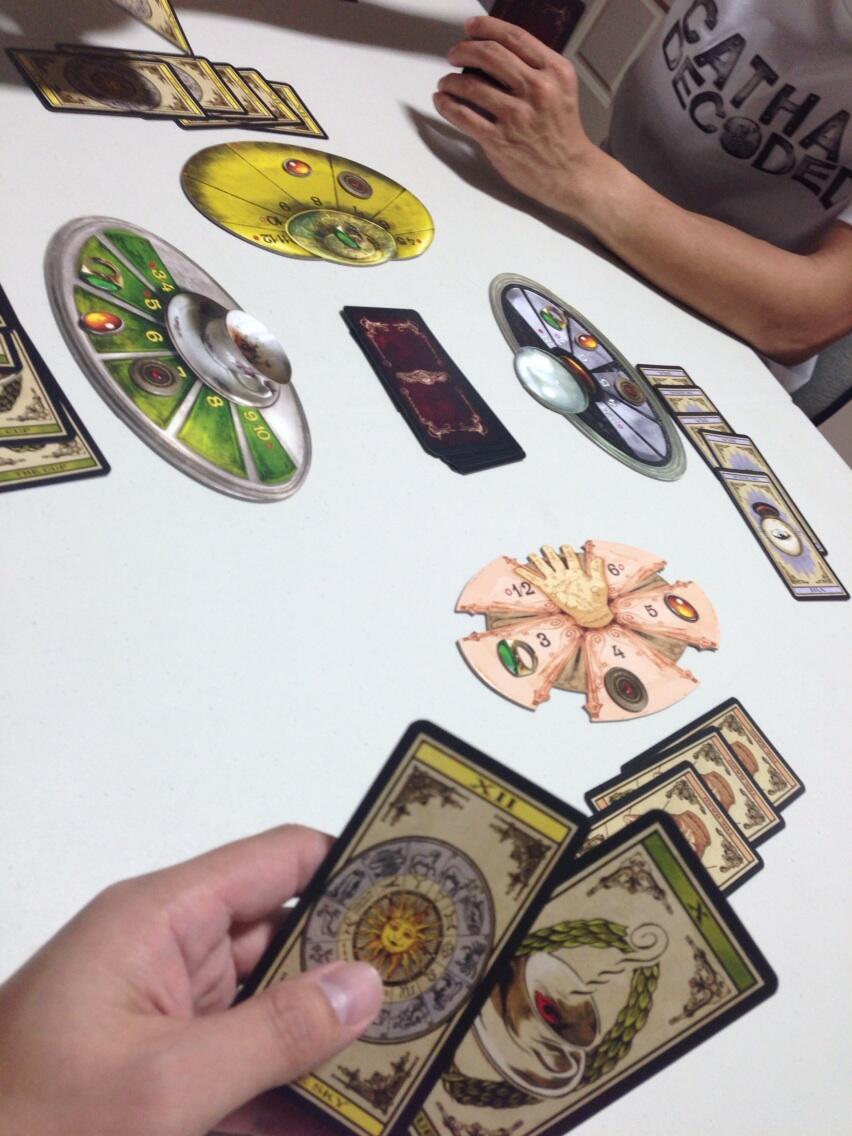 |
| Wait did I already see 4 yellows? Is that the only Yellow left in the game? |
Game Session and Thoughts:
This is my first play of the game. Now I have seen this game and heard of its hype at GENCON 2012 but I had thought it was a light filler and did not look too much into it. Besides, at that time I was more interested in Seasons from Asmodee :P Boy was that a mistake after playing my first game last week.
The game is quite simple to play. Players will have a certain number of cards in their hand. These cards belong to 1 of 4 colors (red, yellow, green and white). At the start, you will pass a certain number of cards to the player on your right. This "event" will occur a few times during the game, depending on how many cards all players have left as well as the number of players.
During your turn, you have to play a card and then move your token for that location (i.e. play yellow card, activate your token in the yellow area) either to another spot. Now each location has a few sections with numbers on them. The aim of the game is to place your token on the number that you want to guess for that color. You are guessing at the end of that round, how many cards of that color has been revealed. If you are spot on, you will score 3 points. If you are adjacent to that number, 1 point and if you are way off, you will be penalized 1 point. There are sections at the extreme ends that will give you extra bonus points if you score.
After each player has had a chance to be the start player, the player with the most total points will win the game.
What surprised me was how deep the game eventually became for me. Initially after the rules were explained, I was thinking "Oh, this will be a simple game to play..." Then as the game progressed I was thinking "ok I have seen 3 Yellows, shall I pass them along or keep?" Then it was "ok now I have received some more Yellow cards... now wait how many was that ?"
During my turn, I suddenly realised "Oh my... I will need to play a card AND move my token EVERYTIME? That will mean that if I knew the exact count (or have a pretty good idea), I will still need to play my cards in such a way I will still remain in that number to win the 3 points!"
As you can tell by now, this game has many layers and its not as straight forward nor as simple as I had initially thought. Do you pass your card to someone else so that you can lock in your choice ? Or do you choose to forgo your choice (you can move your token back to the starting point and not suffer penalty) so that you will not get penalty ? So many choices and it makes for a nice meaty game.
Oh and production value is really good and the locations look very realistic and 3D. Art is also nicely done.
Pet Peeves:
So does this game have issues? Well if you are prone to Analysis Paralysis then yea. You may be trying to remember all the cards that have been played, start to calculate the probabilities and thus not be able to make a decision.
Some can also say that the luck of the draw is important. But all these are minor quibbles I feel.
Conclusion:
Well as you can tell by now, this is my biggest surprise and hit for this week. The intricacies and the depth of play really surprised and astounded me. For such an easy game to teach, it sure packs a punch and I highly recommend this game! Go grab yourself a copy now!
PLATO 3000
Game Session and Thoughts:
Been some time since I brought it out to play this and I think that having played a few more of similar type of games (set collection or light card fillers), I think the shine for Plato 3000 is starting to wear off. It could be that the lunch group was suffering from lunch-food coma ( ;P ). It could also be that for 4 players the game doesn't work as well. Might be good for 2 or 3 but maybe for 4, we will need 2 sets to really speed things along. My colleague who played it once before and did not like it initially but after this session she liked the game. She's not too sure why she liked it better this time lol...
Conclusion:
I think that this game really shines with 2 or 3. Though with the influx of similar games like Guildhall and to a lesser extend, Love Letter and Coup, not sure if this has enough legs to carry it past the rest to shine above them. For me so far I think Guildhall and Love Letter seems to be beating Plato 3000.
MORD IM AROSA
Game Session and Thoughts:
I got my own copy after playing it previously and I was eager to break it out with the office and see how it went. We had more fun probably dropping the pieces in and trying to guess where they are than the actual revealing and guessing itself haha. Its interesting in that when we dropped, I could have sworn most of the cubes were stuck in floor 5 or 4 but when we revealed we were surprised there weren't many there. Its amazing how our ears can be deceived and this makes the game that much more challenging. Gameplay wise it is a very light game with the tower as the gimmick. Its good for new comers to get used to what we call boardgames and open their eyes but probably only scratches the very top of my itch for deduction games.
Pet Peeves:
The base where the tower sits on (or table) will probably be the easiest to guess because cubes dropping through the cardboard will not sound the same as the table the tower is resting on. That being said, it can still confuse others especially because your own cube needs to be sitting there else you will be penalised. The other Peeve I have is the way the tower is built. If you have an improper tower (i.e. some of the cardboard pieces aren't sitting nicely) then your tower maybe skewed. Anyway, these are just minor peeves to a light party-like game.
Conclusion:
Definitely not a game for heavy or even medium weight gamers I feel but can only be a light filler with the tower as a gimmick. Its nice to assemble and look at and play it once or twice but in the long run it probably will wear off the freshness of the game. Still, a try before you buy.
AOB
If you would like us to review your games on the podcast and on this blog, do leave a message on boardgamegeek (my nick is duckizz) for me and I will pass you my details. Also, if you would like to support my blog and the podcast, please click on the ads at the side of this blog and leave ratings and reviews for us on iTunes.
THANK YOU!
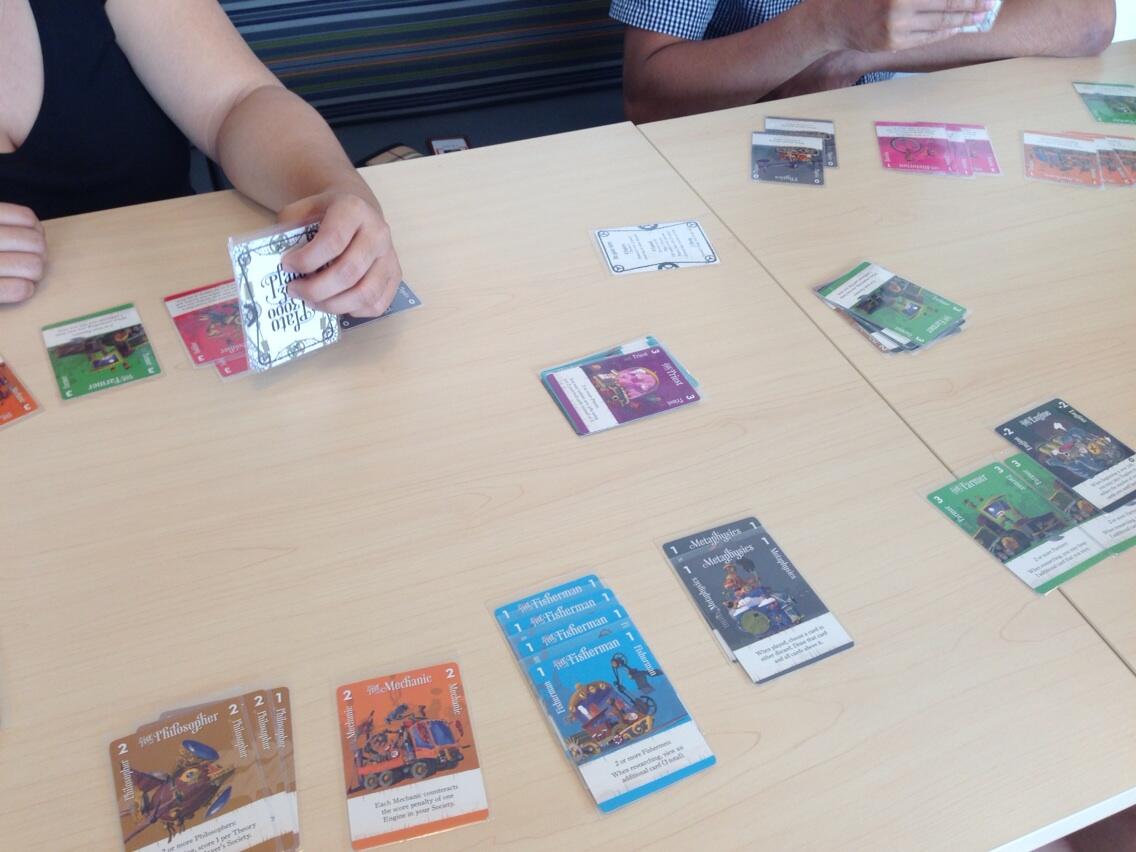
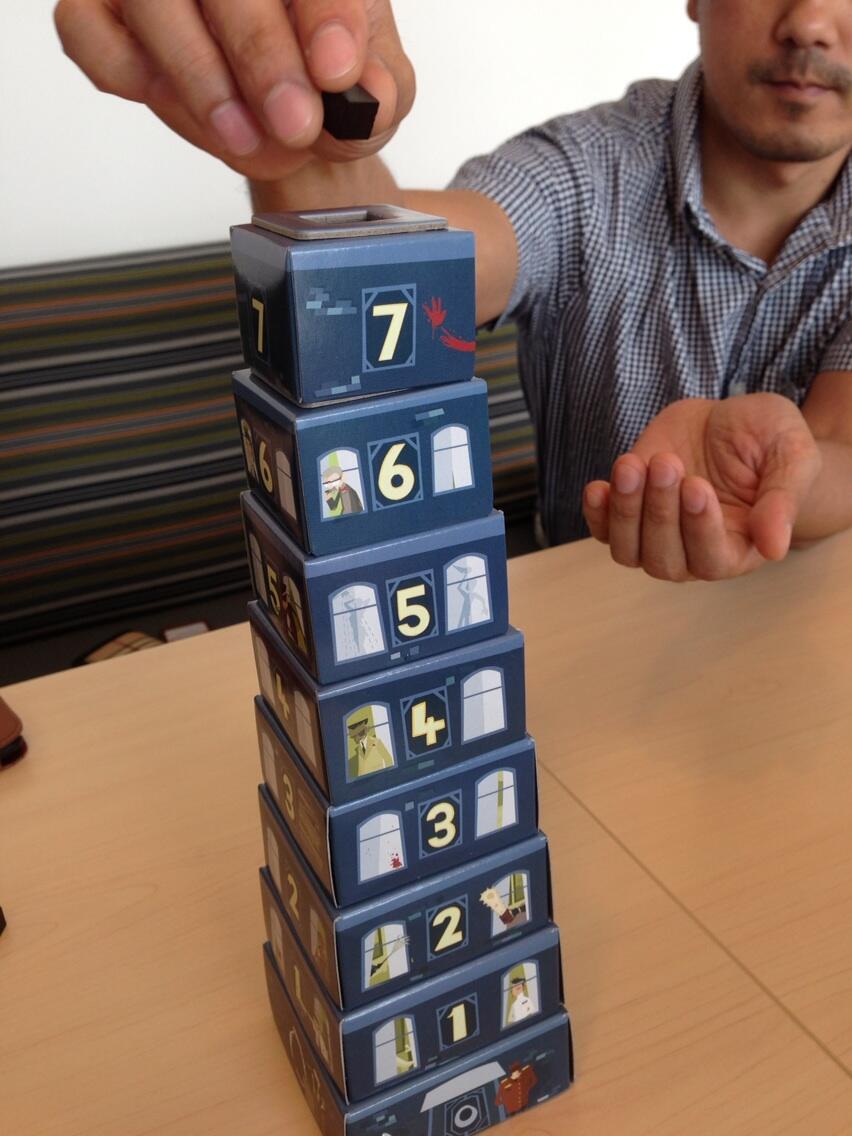
No comments:
Post a Comment